Deep-sea manned submersibles MIR (9 photos)
 Bashny.Net
Bashny.Net
"The World" - a series of Russian research submarine deep water manned submersibles (GOA) for oceanographic research and rescue. Have a dive to a depth of 6 km. Based aboard the research vessel "Akademik Mstislav Keldysh».
In this post I will tell you about these mini submarines:


Deep-sea manned submersibles (GOA), "Mir-1" and "Mir-2" have been built in Finland by Rauma-Repola in 1987. The idea of devices and an initial draft was worked out by the Academy of Sciences of the USSR and CB "Lapis". The devices are designed under the scientific and technical guidance of scientists and engineers of the Institute of Oceanology named after Shirshov.
Creating apparatus was started in May 1985 and ended in November 1987. In December 1987, tests were conducted deepwater units in the Atlantic at a depth of 6170 meters ("Mir-1") and 6120 meters ("Mir-2"). The devices have been installed on the vessel to ensure "Akademik Mstislav Keldysh", built in 1981 in Finland and refurbished in 1987 for work on deep-sea testing devices.
GOA "World 1" and "Mir 2" are identical in construction and are designed for Operating depth of 6000 m. The total capacity of the batteries of the unit is 100 kW / h, which enables underwater operation for 17 to 20 hours of continuous underwater cycle. In addition, it allows the device to both large complex of scientific and navigational equipment.
Submerged speed machine "Peace" is 5 knots. For ballasting he used ballast water. Before leaving the machine from the surface of the sea water fills the plastic main ballast tanks with capacity of 1, 5 cu. m, which blows compressed air when the machine reaches the surface after a dive. Buoyancy apparatus is regulated via a system of variable ballast water by receiving three solid sphere and pumping it from areas of high pressure pump.
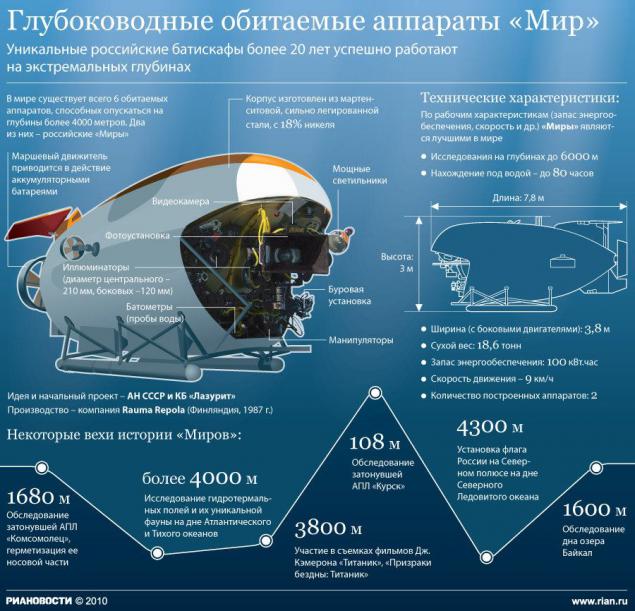
The case is made of martensitic, highly alloyed steel with 18% nickel. The alloy has a yield strength - 150 kg per square mm (from titanium - about 79 kg / mm). Producer: Finnish firm "Lokomo", part of the group "Rauma Repola." Placing Crew GOA "World" consists of three people - a pilot, engineer and scientist-observer.
The length of the apparatus "Mir" 7, 8 m, width (with outboard engine) 3, 8 m, height 3 m. Overview of the inhabited spheres of vehicles "Mir" is provided by three portholes: central, having an inner diameter of 200 mm and two lateral diameter of 120 mm. Location portholes gives a wide viewing angle for pilots and observers. Buoyancy apparatus "Mir" at the bottom is 290 kg. Dry weight of 18, 6 tons. The stock livelihoods 246 pers. / H. GOA "World" equipped with navigational and scientific equipment, photos and video systems, manipulators, sampling devices, and so on. D.
Emergency rescue device consists of at sintaktikovogo buoy discharged crew, attached to it with Kevlar cable length of 7000 m, of which the half hitch is lowered (such as railway automatic coupler). She comes to the device, then there is an automatic hitch and the machine lift force on a long cable length of 6500 m, with a tensile strength of about ten tons.
As of 2008, in the world, except for Russian "Mir-1" and "Mir-2", there are two more machine (built was three). American machine "Sea Cliff» (Sea Cliff) (Eng. DSV Sea Cliff), which is now being converted, the French "Nautile» (Nautile) (fr. Nautile), both of a diving depth of 6000 meters, and the Japanese "Shinkai 6500» (Shinkai 6500), set a record dive for existing vehicles in the 6527 meters.
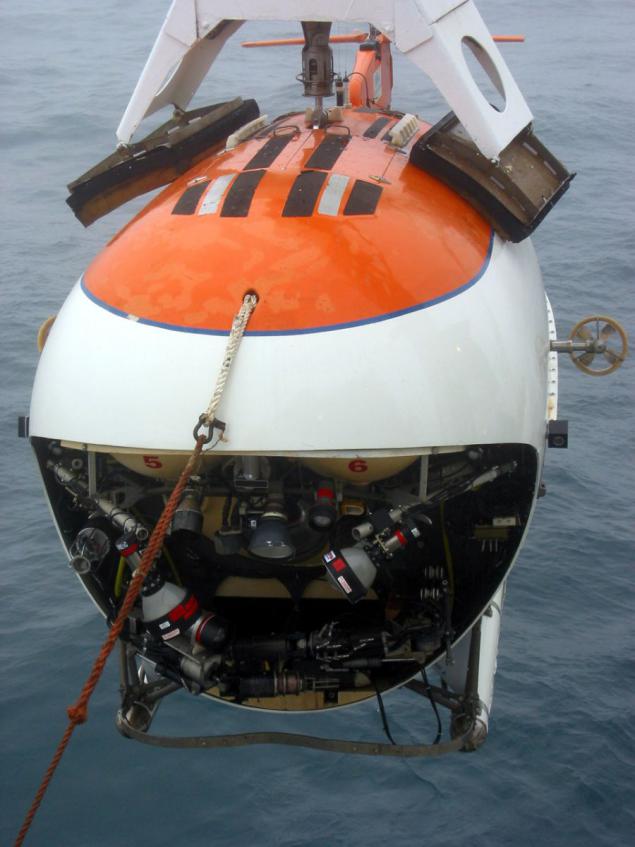
Using GOA "Mir-1" and "Mir-2" carried out 35 expeditions in the Atlantic, Pacific and Indian oceans, of which nine expeditions to eliminate the consequences of accidents of nuclear submarines (NPS) "Komsomolets" and "Kursk". A number of new deepwater technologies and methods that will allow for long-term radiation monitoring in the nuclear submarine "Komsomolets", which is located at the bottom of the Norwegian Sea at a depth of 1,700 meters, and make a partial sealing of the bow of the boat. In the area of destruction of nuclear submarine "Komsomolets" in the Norwegian Sea was conducted seven expeditions between the years 1989-1998.
At the end of September 2000 machines were used to examine the nuclear submarine "Kursk". Russian scientific institutions, developed a technique which enabled devices via the "Mir" to conduct a detailed inspection of nuclear submarine "Kursk", the cause of its failure and to develop measures to eliminate the consequences of the accident.
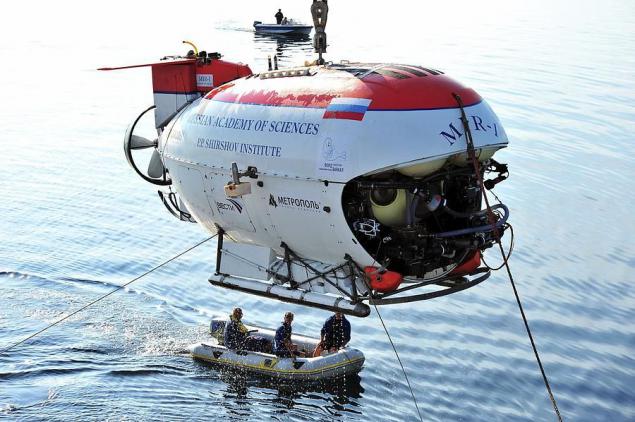
In 1991 and 1995, with the help of the "world" research body made of "Titanic", which lies at a depth of 3800 meters. During the dives were conducted unique filming that were used to create artistic and educational films, among them - Titanica, Titanic, Bismarck, Aliens of the Deep, Ghost of the Abyss.
In January-September 2004 by the Institute of Oceanology of the Russian Academy of Sciences in cooperation with the Federal State Unitary Enterprise "Torch" was overhauled vehicles "Mir" with their complete dismantling, testing the strength of buildings, partial replacement of elements, assemblies and equipment, followed by assembly and testing of the newly assembled vehicles. As a result of "Mir-1" and "Mir-2" have received certificates for class on an international register "Germanischer Lloyd" until 2014.
In January-September 2004 by the Institute of Oceanology of the Russian Academy of Sciences in cooperation with the Federal State Unitary Enterprise "Torch" was overhauled vehicles "Mir" with their complete dismantling, testing the strength of buildings, partial replacement of elements, assemblies and equipment, followed by assembly and testing of the newly assembled vehicles. As a result of "Mir-1" and "Mir-2" have received certificates for class on an international register "Germanischer Lloyd" until 2014.

August 2, 2007 as part of the expedition "Arktika-2007" was carried out the world's first deep-sea manned submersibles descend "Peace" at the geographic North Pole at a depth of 4300 meters. During this unprecedented immersion in the bottom it was set titanium Russian flag and a capsule with a message to future generations. Devices withstood the pressure of 430 atmospheres. Achievements of the expedition recorded in the Guinness Book of Records.
Arctic dive caused a great public outcry, as some Russian commentators expressed the view that Russia "stake out" their rights to the area of the ocean floor between the New Siberian Islands and the North Pole, but from the standpoint of international law, this action is a legal void.
Dive deep water manned vehicles "Mir-1" and "Mir-2" at the North Pole - the first in history. This expedition will allow the first detailed study of the structure of the floor in the polar region and to clarify the boundaries of the Russian shelf in the area extending from the New Siberian Islands to the North Pole.
In fact, one of the goals of the expedition - to establish whether the underwater Lomonosov and Mendeleyev ridges, which extend to Greenland, a geological extension of Russia's continental shelf.
Also, members of the expedition carried out a series of scientific experiments, took soil samples and fauna. In addition, as part of a dive in the ocean floor has been installed and left the Russian tricolor capsule with a message of Russians, the "Heart of the World" - the mascot of the youth team, "Celestial Odyssey" and the flag of "United Russia».
Asked about the problems of the current Russian research expedition to the North Pole, Russian Foreign Minister Sergei Lavrov said: "The aim of this expedition - not to stake Russia's rights, but to prove that our shelf extends to the North Pole." The Minister expressed the hope that the current expedition and dive bathyscaphe at the North Pole "will provide additional scientific evidence that we are going to achieve».
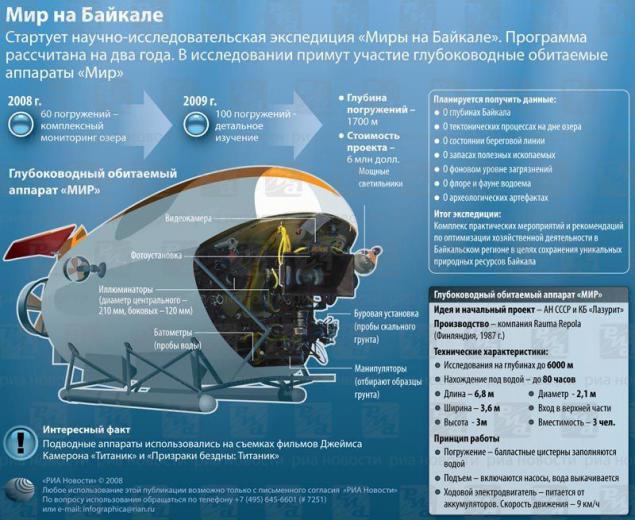
In 2008, two Russian submersibles completed a dive to the bottom of Lake Baikal and well up to the surface. For the first dive was chosen close to the point of Olkhon Island, about 10 km east from the coast of Lake Baikal between Cape Izhimei and Hara Khushun, where the lake reaches its maximum depth. Expeditions lucky with the weather: if on Monday at Lake Baikal was a storm, two-meter waves and continuous rain, the morning on Tuesday established a complete calm and bright sunshine. "Mir-1" is piloted by the chief of the expedition, head of the Laboratory of scientific exploitation of deep-sea manned submersibles Institute of Oceanology, Russian Academy of Sciences, Professor Anatoly Sagalevich.
With him on board are President of the Republic of Buryatia Vyacheslav Nagovicyn and chairman of the Board of Trustees of the Fund for Protection of Lake Baikal Mikhail Slipenchuk. In the second crew - pilot Yevgeny Chernyaev, a State Duma deputy Vladimir Gruzdev and director of the Baikal Institute of Nature RAS Arnold Tulokhonov.
Recall Baikal - the deepest in the world inland body of water and the largest reservoir of fresh water. In June 2008, the results of an Internet survey of the lake has been recognized as one of the Seven Wonders of Russia.
In August-September bathyscaphes "Mir-1" and "Mir-2" have made 60 dives at various points of Baikal. Then the expedition was interrupted for the winter. For the year 2009 it was carried out 100 dives.
Scientists have conducted visual observations, we took water samples at different depths studied the fauna of the lake and the geological structure of the bottom. In addition, they hoped to find in the depths of the lake archaeological artifacts.
According to the deputy of the State Duma, the famous polar explorer Artur Chilingarov, also involved in the expedition, the main thing for the participants - not a record dive, and concern for the environment of Lake Baikal.
"Any dive - a page in history. No records we are not going to put. We want to pay attention and tell you what you need to take the Russian government to save the lake, "- said earlier Chilingarov.
Prime Minister of Russia Vladimir Putin dives in Lake August 1, 2009. A total of lightness "tour" on the machine "Peace 1" at the bottom of the lake took about 4 hours. During the dive, Putin made contact with journalists. At the time, "Peace 1" is at the deepest point of the lake south of 1395 meters. Putin admitted to reporters that he had been somewhat surprised by the opacity of the water, calling it "plankton soup».

James Cameron dives in Lake Baikal August 16, 2010 the day of his birth, and spent under the water four and a half hours. The maximum depth at which he found himself, was 1380 meters.
In 2011, the Russian mini-submarine "Mir-1" and "Mir-2" held the first dive to the bottom of Lake Geneva - one of the biggest, but virtually unexplored waters of Europe. A full-scale program was launched on the eve of his studies and will continue throughout the summer. In Switzerland and France, wanted to know what lies beneath this picturesque water surface, and crave discovery.
The first went to a depth of Hero of Russia Anatoly Sagalevich (he leads the expedition), American Don Walsh (he was at the bottom of the Mariana Trench) and the Swiss Bertrand Piccard. For him, however, accustomed to the other element. Picard - aeronaut and inventor of the first airplane on solar.
Bathyscaphe reached the level of almost 300 meters - it is the maximum value for Lake Geneva. According to Anatoly Sagalevich, spotted the wreckage at the bottom of the steamer "Ron" (his downfall century ago claimed 15 lives) and a few fish. In front of it was still about a hundred dives fence soil and water samples.
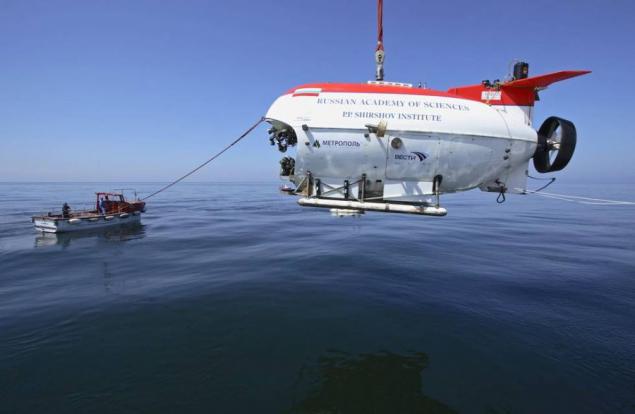
For 20 years, GOA "Mir" made more than 800 dives, about 80 percent of which were performed at depths of 3,000 to 6,000 meters. Thus there was no emergency. Undoubtedly, it is due to the professional group of submariners Institute of Oceanology, securing work GOA "Mir" - from the development of new equipment, modernization of Goa, of repair and maintenance works to piloting vehicles under water.
Features submersibles "Mir" Operating depth - 6000 meters Being under water - up to 80 hours of reserve power supply - 100 kWh stock livelihoods - 246 man-hour maximum speed - 5 knots buoyancy (from the surface) - Dry weight 290 kg - 18, 6 tons Length - 7, 8 meters wide (with outboard engine) - 3, 8 meters Height - 3 meters diameter - 2, 1 m Crew - 3 people escape from the top of the operating principle of immersion - the ballast tanks filled with water rise - off pumps, water is pumped Threaded motor - powered by batteries. Travel speed - 9 km / h.

In this post I will tell you about these mini submarines:


Deep-sea manned submersibles (GOA), "Mir-1" and "Mir-2" have been built in Finland by Rauma-Repola in 1987. The idea of devices and an initial draft was worked out by the Academy of Sciences of the USSR and CB "Lapis". The devices are designed under the scientific and technical guidance of scientists and engineers of the Institute of Oceanology named after Shirshov.
Creating apparatus was started in May 1985 and ended in November 1987. In December 1987, tests were conducted deepwater units in the Atlantic at a depth of 6170 meters ("Mir-1") and 6120 meters ("Mir-2"). The devices have been installed on the vessel to ensure "Akademik Mstislav Keldysh", built in 1981 in Finland and refurbished in 1987 for work on deep-sea testing devices.
GOA "World 1" and "Mir 2" are identical in construction and are designed for Operating depth of 6000 m. The total capacity of the batteries of the unit is 100 kW / h, which enables underwater operation for 17 to 20 hours of continuous underwater cycle. In addition, it allows the device to both large complex of scientific and navigational equipment.
Submerged speed machine "Peace" is 5 knots. For ballasting he used ballast water. Before leaving the machine from the surface of the sea water fills the plastic main ballast tanks with capacity of 1, 5 cu. m, which blows compressed air when the machine reaches the surface after a dive. Buoyancy apparatus is regulated via a system of variable ballast water by receiving three solid sphere and pumping it from areas of high pressure pump.

The case is made of martensitic, highly alloyed steel with 18% nickel. The alloy has a yield strength - 150 kg per square mm (from titanium - about 79 kg / mm). Producer: Finnish firm "Lokomo", part of the group "Rauma Repola." Placing Crew GOA "World" consists of three people - a pilot, engineer and scientist-observer.
The length of the apparatus "Mir" 7, 8 m, width (with outboard engine) 3, 8 m, height 3 m. Overview of the inhabited spheres of vehicles "Mir" is provided by three portholes: central, having an inner diameter of 200 mm and two lateral diameter of 120 mm. Location portholes gives a wide viewing angle for pilots and observers. Buoyancy apparatus "Mir" at the bottom is 290 kg. Dry weight of 18, 6 tons. The stock livelihoods 246 pers. / H. GOA "World" equipped with navigational and scientific equipment, photos and video systems, manipulators, sampling devices, and so on. D.
Emergency rescue device consists of at sintaktikovogo buoy discharged crew, attached to it with Kevlar cable length of 7000 m, of which the half hitch is lowered (such as railway automatic coupler). She comes to the device, then there is an automatic hitch and the machine lift force on a long cable length of 6500 m, with a tensile strength of about ten tons.
As of 2008, in the world, except for Russian "Mir-1" and "Mir-2", there are two more machine (built was three). American machine "Sea Cliff» (Sea Cliff) (Eng. DSV Sea Cliff), which is now being converted, the French "Nautile» (Nautile) (fr. Nautile), both of a diving depth of 6000 meters, and the Japanese "Shinkai 6500» (Shinkai 6500), set a record dive for existing vehicles in the 6527 meters.

Using GOA "Mir-1" and "Mir-2" carried out 35 expeditions in the Atlantic, Pacific and Indian oceans, of which nine expeditions to eliminate the consequences of accidents of nuclear submarines (NPS) "Komsomolets" and "Kursk". A number of new deepwater technologies and methods that will allow for long-term radiation monitoring in the nuclear submarine "Komsomolets", which is located at the bottom of the Norwegian Sea at a depth of 1,700 meters, and make a partial sealing of the bow of the boat. In the area of destruction of nuclear submarine "Komsomolets" in the Norwegian Sea was conducted seven expeditions between the years 1989-1998.
At the end of September 2000 machines were used to examine the nuclear submarine "Kursk". Russian scientific institutions, developed a technique which enabled devices via the "Mir" to conduct a detailed inspection of nuclear submarine "Kursk", the cause of its failure and to develop measures to eliminate the consequences of the accident.

In 1991 and 1995, with the help of the "world" research body made of "Titanic", which lies at a depth of 3800 meters. During the dives were conducted unique filming that were used to create artistic and educational films, among them - Titanica, Titanic, Bismarck, Aliens of the Deep, Ghost of the Abyss.
In January-September 2004 by the Institute of Oceanology of the Russian Academy of Sciences in cooperation with the Federal State Unitary Enterprise "Torch" was overhauled vehicles "Mir" with their complete dismantling, testing the strength of buildings, partial replacement of elements, assemblies and equipment, followed by assembly and testing of the newly assembled vehicles. As a result of "Mir-1" and "Mir-2" have received certificates for class on an international register "Germanischer Lloyd" until 2014.
In January-September 2004 by the Institute of Oceanology of the Russian Academy of Sciences in cooperation with the Federal State Unitary Enterprise "Torch" was overhauled vehicles "Mir" with their complete dismantling, testing the strength of buildings, partial replacement of elements, assemblies and equipment, followed by assembly and testing of the newly assembled vehicles. As a result of "Mir-1" and "Mir-2" have received certificates for class on an international register "Germanischer Lloyd" until 2014.

August 2, 2007 as part of the expedition "Arktika-2007" was carried out the world's first deep-sea manned submersibles descend "Peace" at the geographic North Pole at a depth of 4300 meters. During this unprecedented immersion in the bottom it was set titanium Russian flag and a capsule with a message to future generations. Devices withstood the pressure of 430 atmospheres. Achievements of the expedition recorded in the Guinness Book of Records.
Arctic dive caused a great public outcry, as some Russian commentators expressed the view that Russia "stake out" their rights to the area of the ocean floor between the New Siberian Islands and the North Pole, but from the standpoint of international law, this action is a legal void.
Dive deep water manned vehicles "Mir-1" and "Mir-2" at the North Pole - the first in history. This expedition will allow the first detailed study of the structure of the floor in the polar region and to clarify the boundaries of the Russian shelf in the area extending from the New Siberian Islands to the North Pole.
In fact, one of the goals of the expedition - to establish whether the underwater Lomonosov and Mendeleyev ridges, which extend to Greenland, a geological extension of Russia's continental shelf.
Also, members of the expedition carried out a series of scientific experiments, took soil samples and fauna. In addition, as part of a dive in the ocean floor has been installed and left the Russian tricolor capsule with a message of Russians, the "Heart of the World" - the mascot of the youth team, "Celestial Odyssey" and the flag of "United Russia».
Asked about the problems of the current Russian research expedition to the North Pole, Russian Foreign Minister Sergei Lavrov said: "The aim of this expedition - not to stake Russia's rights, but to prove that our shelf extends to the North Pole." The Minister expressed the hope that the current expedition and dive bathyscaphe at the North Pole "will provide additional scientific evidence that we are going to achieve».

In 2008, two Russian submersibles completed a dive to the bottom of Lake Baikal and well up to the surface. For the first dive was chosen close to the point of Olkhon Island, about 10 km east from the coast of Lake Baikal between Cape Izhimei and Hara Khushun, where the lake reaches its maximum depth. Expeditions lucky with the weather: if on Monday at Lake Baikal was a storm, two-meter waves and continuous rain, the morning on Tuesday established a complete calm and bright sunshine. "Mir-1" is piloted by the chief of the expedition, head of the Laboratory of scientific exploitation of deep-sea manned submersibles Institute of Oceanology, Russian Academy of Sciences, Professor Anatoly Sagalevich.
With him on board are President of the Republic of Buryatia Vyacheslav Nagovicyn and chairman of the Board of Trustees of the Fund for Protection of Lake Baikal Mikhail Slipenchuk. In the second crew - pilot Yevgeny Chernyaev, a State Duma deputy Vladimir Gruzdev and director of the Baikal Institute of Nature RAS Arnold Tulokhonov.
Recall Baikal - the deepest in the world inland body of water and the largest reservoir of fresh water. In June 2008, the results of an Internet survey of the lake has been recognized as one of the Seven Wonders of Russia.
In August-September bathyscaphes "Mir-1" and "Mir-2" have made 60 dives at various points of Baikal. Then the expedition was interrupted for the winter. For the year 2009 it was carried out 100 dives.
Scientists have conducted visual observations, we took water samples at different depths studied the fauna of the lake and the geological structure of the bottom. In addition, they hoped to find in the depths of the lake archaeological artifacts.
According to the deputy of the State Duma, the famous polar explorer Artur Chilingarov, also involved in the expedition, the main thing for the participants - not a record dive, and concern for the environment of Lake Baikal.
"Any dive - a page in history. No records we are not going to put. We want to pay attention and tell you what you need to take the Russian government to save the lake, "- said earlier Chilingarov.
Prime Minister of Russia Vladimir Putin dives in Lake August 1, 2009. A total of lightness "tour" on the machine "Peace 1" at the bottom of the lake took about 4 hours. During the dive, Putin made contact with journalists. At the time, "Peace 1" is at the deepest point of the lake south of 1395 meters. Putin admitted to reporters that he had been somewhat surprised by the opacity of the water, calling it "plankton soup».

James Cameron dives in Lake Baikal August 16, 2010 the day of his birth, and spent under the water four and a half hours. The maximum depth at which he found himself, was 1380 meters.
In 2011, the Russian mini-submarine "Mir-1" and "Mir-2" held the first dive to the bottom of Lake Geneva - one of the biggest, but virtually unexplored waters of Europe. A full-scale program was launched on the eve of his studies and will continue throughout the summer. In Switzerland and France, wanted to know what lies beneath this picturesque water surface, and crave discovery.
The first went to a depth of Hero of Russia Anatoly Sagalevich (he leads the expedition), American Don Walsh (he was at the bottom of the Mariana Trench) and the Swiss Bertrand Piccard. For him, however, accustomed to the other element. Picard - aeronaut and inventor of the first airplane on solar.
Bathyscaphe reached the level of almost 300 meters - it is the maximum value for Lake Geneva. According to Anatoly Sagalevich, spotted the wreckage at the bottom of the steamer "Ron" (his downfall century ago claimed 15 lives) and a few fish. In front of it was still about a hundred dives fence soil and water samples.

For 20 years, GOA "Mir" made more than 800 dives, about 80 percent of which were performed at depths of 3,000 to 6,000 meters. Thus there was no emergency. Undoubtedly, it is due to the professional group of submariners Institute of Oceanology, securing work GOA "Mir" - from the development of new equipment, modernization of Goa, of repair and maintenance works to piloting vehicles under water.
Features submersibles "Mir" Operating depth - 6000 meters Being under water - up to 80 hours of reserve power supply - 100 kWh stock livelihoods - 246 man-hour maximum speed - 5 knots buoyancy (from the surface) - Dry weight 290 kg - 18, 6 tons Length - 7, 8 meters wide (with outboard engine) - 3, 8 meters Height - 3 meters diameter - 2, 1 m Crew - 3 people escape from the top of the operating principle of immersion - the ballast tanks filled with water rise - off pumps, water is pumped Threaded motor - powered by batteries. Travel speed - 9 km / h.

Tags
See also
How to collect helicopters (19 photos)
Mariana Trench - the deepest place in the world (21 photos)
A new generation of nuclear-powered cruiser "Severodvinsk" (13 photos)
The largest dump truck in the world (24 photos)
Memorial Museum of Cosmonautics at the Exhibition Center (46 photos)
How do cosmic pictures (11 photos)
Dagestan - Chirjurtsky hydroelectric (50 photos)
13 photos that changed the world (13 photos)
The history of the oldest Black Sea Fleet (8 pics + text)
An asterisk
















